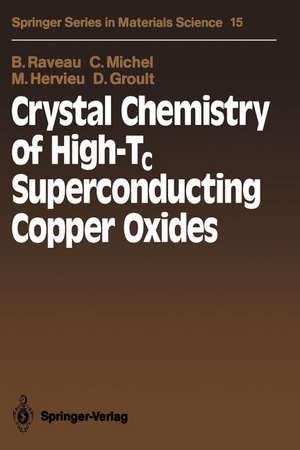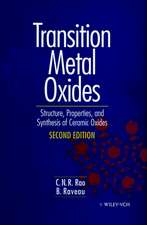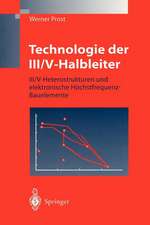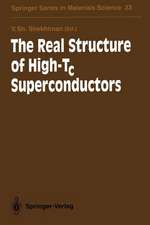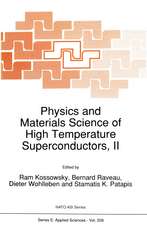Crystal Chemistry of High-Tc Superconducting Copper Oxides: Springer Series in Materials Science, cartea 15
Autor Bernard Raveau, Claude Michel, Maryvonne Hervieu, Daniel Groulten Limba Engleză Paperback – 8 dec 2011
Din seria Springer Series in Materials Science
- 18%
 Preț: 1820.22 lei
Preț: 1820.22 lei - 18%
 Preț: 776.09 lei
Preț: 776.09 lei - 24%
 Preț: 689.69 lei
Preț: 689.69 lei - 18%
 Preț: 968.96 lei
Preț: 968.96 lei - 20%
 Preț: 568.95 lei
Preț: 568.95 lei - 18%
 Preț: 953.65 lei
Preț: 953.65 lei - 18%
 Preț: 902.36 lei
Preț: 902.36 lei - 18%
 Preț: 953.65 lei
Preț: 953.65 lei - 20%
 Preț: 948.42 lei
Preț: 948.42 lei - 18%
 Preț: 1143.07 lei
Preț: 1143.07 lei - 18%
 Preț: 1111.53 lei
Preț: 1111.53 lei - 18%
 Preț: 1103.62 lei
Preț: 1103.62 lei - 18%
 Preț: 1225.94 lei
Preț: 1225.94 lei -
 Preț: 473.91 lei
Preț: 473.91 lei - 18%
 Preț: 782.42 lei
Preț: 782.42 lei -
 Preț: 433.47 lei
Preț: 433.47 lei - 18%
 Preț: 1116.40 lei
Preț: 1116.40 lei - 18%
 Preț: 946.24 lei
Preț: 946.24 lei - 18%
 Preț: 945.20 lei
Preț: 945.20 lei - 18%
 Preț: 1114.21 lei
Preț: 1114.21 lei - 15%
 Preț: 641.20 lei
Preț: 641.20 lei - 18%
 Preț: 958.56 lei
Preț: 958.56 lei - 18%
 Preț: 1224.36 lei
Preț: 1224.36 lei - 15%
 Preț: 644.82 lei
Preț: 644.82 lei - 24%
 Preț: 833.45 lei
Preț: 833.45 lei - 24%
 Preț: 1060.36 lei
Preț: 1060.36 lei - 18%
 Preț: 964.10 lei
Preț: 964.10 lei - 18%
 Preț: 1224.36 lei
Preț: 1224.36 lei - 18%
 Preț: 1221.20 lei
Preț: 1221.20 lei - 18%
 Preț: 946.87 lei
Preț: 946.87 lei - 18%
 Preț: 1836.92 lei
Preț: 1836.92 lei - 15%
 Preț: 643.34 lei
Preț: 643.34 lei - 18%
 Preț: 1246.32 lei
Preț: 1246.32 lei - 18%
 Preț: 956.81 lei
Preț: 956.81 lei - 18%
 Preț: 953.52 lei
Preț: 953.52 lei - 15%
 Preț: 637.59 lei
Preț: 637.59 lei
Preț: 390.84 lei
Nou
Puncte Express: 586
Preț estimativ în valută:
74.79€ • 79.97$ • 62.36£
74.79€ • 79.97$ • 62.36£
Carte tipărită la comandă
Livrare economică 18 aprilie-02 mai
Preluare comenzi: 021 569.72.76
Specificații
ISBN-13: 9783642838941
ISBN-10: 3642838944
Pagini: 344
Ilustrații: X, 331 p. 158 illus.
Dimensiuni: 155 x 235 x 18 mm
Greutate: 0.48 kg
Ediția:Softcover reprint of the original 1st ed. 1991
Editura: Springer Berlin, Heidelberg
Colecția Springer
Seria Springer Series in Materials Science
Locul publicării:Berlin, Heidelberg, Germany
ISBN-10: 3642838944
Pagini: 344
Ilustrații: X, 331 p. 158 illus.
Dimensiuni: 155 x 235 x 18 mm
Greutate: 0.48 kg
Ediția:Softcover reprint of the original 1st ed. 1991
Editura: Springer Berlin, Heidelberg
Colecția Springer
Seria Springer Series in Materials Science
Locul publicării:Berlin, Heidelberg, Germany
Public țintă
ResearchCuprins
1. Introduction: Superconductivity in Oxides Before 1986.- 2. Phases of the Systems A-La-Ca-Cu-O and A-Y-Ca-Cu-O (A = Ca, Sr, Ba): Structural Aspects.- 2.1 Copper Chemistry in Oxides: Oxidation States and Coordination.- 2.2 The Ternary Systems La-Cu-O and A-Cu-O (A = Ca,Sr,Ba).- 2.3 The Pseudoternary Systems A-La-Cu-O (A = Ca,Sr,Ba).- 2.4 The Pseudoternary System Y-Ba-Cu-O.- 2.5 The Systems Ln-Sr-Cu-O (Ln ? La).- 3. Electron Transport Properties Connected with Oxygen Nonstoichiometry.- 3.1 Electron Transport Properties in Cuprates Related to the Perovskite: General Considerations.- 3.2 Oxides with the K2NiF4-Type Structure.- 3.3 Oxides with the Oxygen-Deficient Sr3Ti2O7-Type Structure.- 3.4 Oxides with the Oxygen-Deficient Perovskite Structure.- 4. Substitutions in La2CuO4-Type and YBa2Cu3O7-Type Superconductors.- 4.1 Substitution on the Rare-Earth Sites.- 4.2 Substitution on the Copper Sites.- 4.3 Substitutions on Other Sites.- 5. Bismuth, Thallium and Lead Superconducting Cuprates.- 5.1 Bismuth Alkaline-Earth Superconducting Cuprates.- 5.2 Thallium Alkaline-Earth Superconducting Cuprates.- 5.3 Lead Alkaline-Earth Superconducting Cuprates.- 5.4 Layered Cuprates Involving Double Fluorite-Type Layers.- 5.5 Structural Relationships.- 6. Extended Defects in Superconducting Oxides: High-Resolution Electron Microscopy.- 6.1 YBa2Cu3O7-Type Superconductors: Ordering in the Perovskite Framework.- 6.3 Layer Interconnections.- 6.4 Extra Spots in ED Patterns: An Amazing Variety.- 6.5 Domains and Boundaries.- 7. Irradiation Effects in the High-Tc Superconducting Oxides.- 7.1 Radiation Damage in Solids.- 7.2 Radiation Damage by Electrons and Fast Neutrons in Copper Oxide Superconductors.- 7.3 Phase Transformations Induced by Fast Heavy Ions in the High-Tc Copper Oxides.- 7.4Conclusions.- 8. Concluding Remarks.- 8.1 Low Dimensionality of the Structure.- 8.2 Mixed Valence of Copper and Hole Delocalization.- 8.3 The Model of Copper Disproportionation.- 8.4 Role of the Lone Pair Cations and of the Alkaline Earth Elements.- References.
